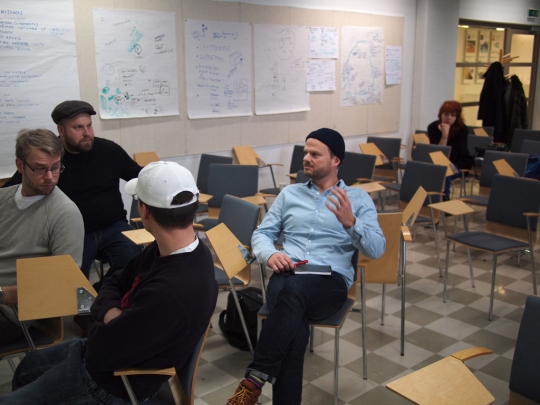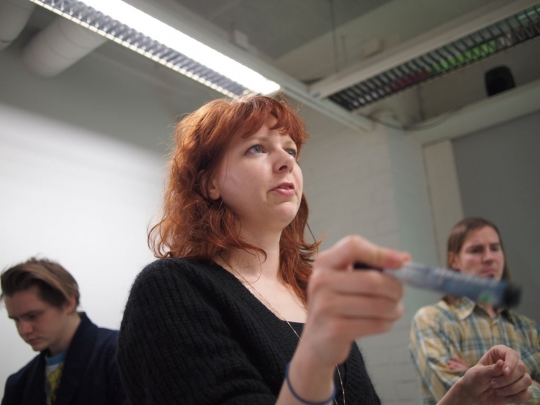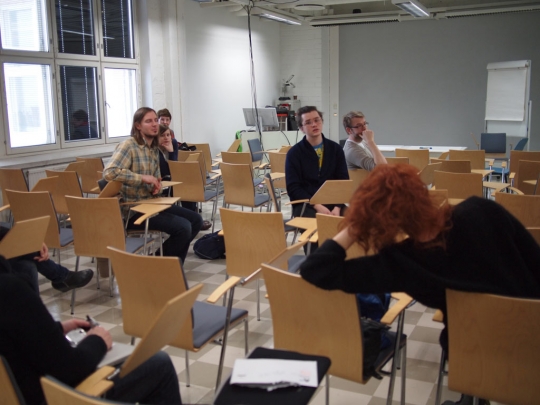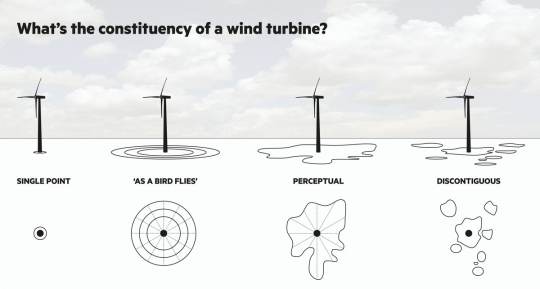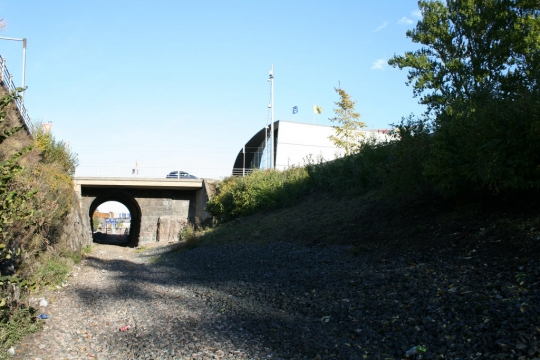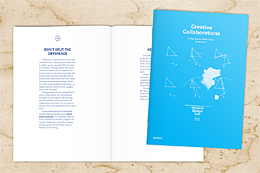All posts tagged Urbanism
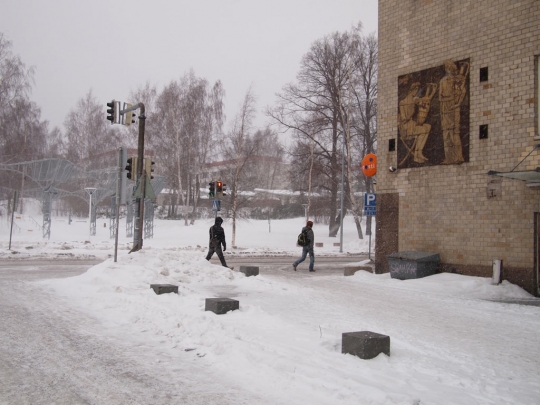
Aalto University School of Art & Design, Arabianranta campus.
A very busy but productive week, which started in a snowstorm at Aalto University, where I was running a 2-day workshop on the Master of Arts (MoA) course, with my friends and colleagues Joseph Grima of Domus in Milan and Bryan of this parish.
I've known Joseph for years (from Postopolis days), so it was nice to work together with him again. (By the way, in little over a year, Joseph has transformed the venerable Italian institution into perhaps the best design magazine around - or certainly up there with Eye and Idea, at least - so Domus is certainly worth checking out, if you haven't seen it recently.)
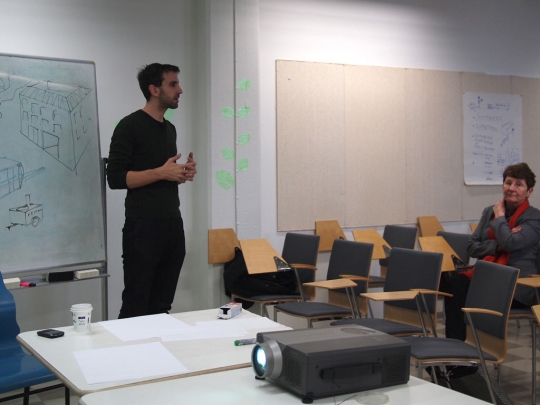
Joseph introducing the workshop.
Our workshop focused on the 'everyday food' angle we've been pursuing over the last six months, and been reporting on here. The 30 or so students were from all over Aalto's design and art disciplines, and so well-suited to such a rich topic. We set the piece with the following brief:
"Design the conditions and context that might use street food as a ‘Trojan horse’ to positively transform Helsinki’s street life & use of public space, citizen engagement & diversity of entrepreneurship, carbon footprint & cultural life."
We gave the students a set of by-now familar characters, such as the Camionette food truck:

and the iconic Helsinki kioski:
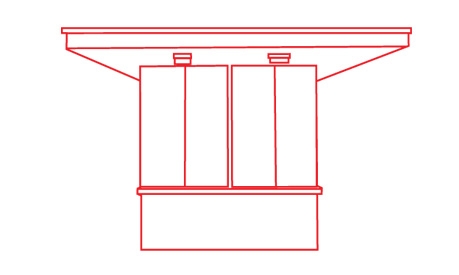
… and numerous other aspects, from wholesale markets to trams, as well as a download of history and context, which you'll be able to read for yourself, shortly.
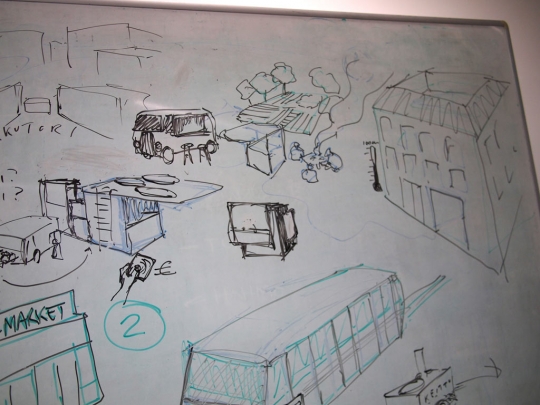
I sketched the board of 'characters' as they emerged over the two days.
They did a great job over the two days, and the last group through (we sort of exquisite corpsed our way through four groups over the two days) had the privilege/pleasure/daunting task of presenting to our panel, which included Ville Relander from City of Helsinki (see earlier entry) and Antto Melasniemi, of local culinary sensations HEL YES!, Atelje Finne, Kuurna, Putte's, and many other things.
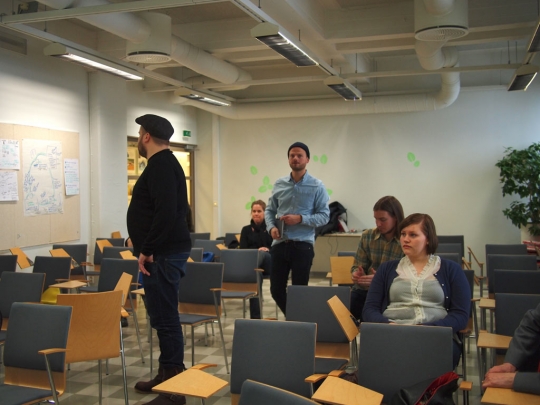
Our fearsome-looking panel arrives.
We'll post the results shortly over at low2no.org, and look to take the work forward in some way. Thanks to Joseph, Aalto and the students for their hard work, and to Ville and Antto for their insight and energy.
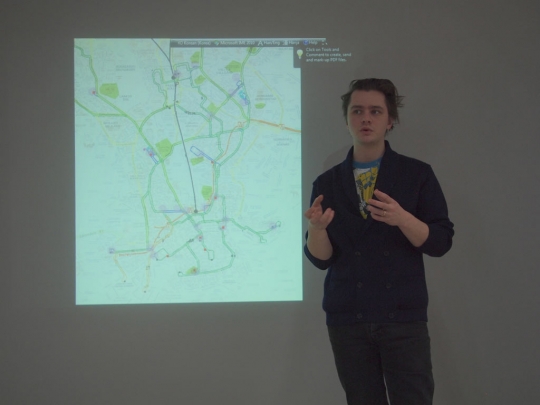
Mapping kioski, disused tramlines and public spaces.
Back to other projects, we actually bookended the week with talk of food, as we ended in discussion with Antto and Elina Forss up at Tukkutori, Kalasatama, about our various food projects. Watch that space; getting very exciting.
On our NIMBY-YIMBY or Brickstarter project (yes, we have to work on our project names), we had an excellent day of reviewing and planning, reflecting on our recent trips to Hamina and Högsåra, and what we learnt. Many things came up, with one of the more interesting conversations concerning how to measure the impact and value of shared public goods - like a wind turbine. We sketched this out on the board in different ways, before Bryan made a more elegant version of diagram-as-question.
It's all getting very interesting. We've started making a hitlist of other projects, beyond windfarms, which deal with new or old models for shared public decision-making at the community scale. Next up, a visit to the University of Helsinki's political scientists, and continued dialogue with people like Wouter Vanstiphout in Rotterdam; he of 'dark matter' and WIMBY fame.
Unrelated news: some researchers appear to have concluded that the democratic model is actually too advanced for many humans to use. Which is unfortunate. Meanwhile, in terms of other models, we note with interest that Putin is the new president of Russia.
And unrelated actiivty last week included more organisational redesign work, focusing on the creation of our new strategic 'focus areas'. Balancing 'internal' organisational design and external project activity is not easy, but we see them as connected activities i.e. to transform the way we do projects, we have to transform the organisation. And indeed vice versa.
Finally here in Helsinki, news (via Lewism, whose great images from a few years ago illustrate this section) of the plans for the long-disused sunken goods railway line that runs through much of the city centre. Known as Baana, it will connect the old ports (incl. current and future Sitra HQs at Ruoholahti and Jätkäsaari) to the centre of the city. In a time when cities worldwide are finding elegant and inspiring new uses for old spaces, it's an amazing opportunity for the city.
However, we're a little disappointed that the CIty's planning department has done little to ensure the project realises its potential. Currently, the 'design' implies a bike lane and pavement. Contemporary city making has long since left behind the idea of city planning departments that deal simply and solely with the physical aspects of infrastructure. To make such a space really sing means engaging with the productive capacity of cities, forging connections to the businesses and community groups that might provide the framework for the activity that happens at Baana. You start with this, and design the physical infrastructure as a flexible platform to support the multitude of activities that a city generates. This means planning can only work as part of a rich mix of approaches, just as with most single-discipline departments forged for another age. More successful approaches are now fundamentally human-centred; we don't make cities in order to make infrastructure, after all. It is a secondary, supporting function.

Baana, a few years back, by Lewism
In other cities, where such projects are much tougher to get off the ground - the City of Helsinki owns much of Helsinki, and has healthier finances than most - these kind of holistic, productive approaches are actually required in order to get things done, necessity being the mother of invention. Here, we often can skip all that, and go straight to the project, which is an incredible luxury (at least for the moment.)
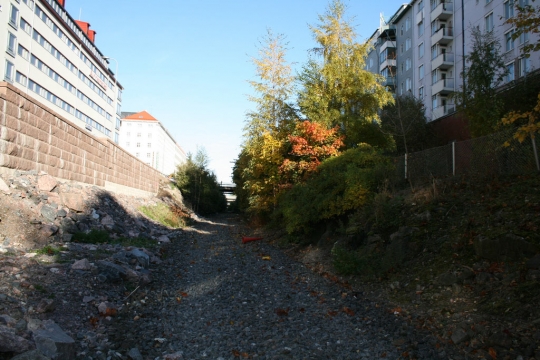
Baana a few years back, by Lewism
But with that luxury has perhaps come a little complacency. For a project that could help change the way that Helsinki works, the way it feels, the way it is, there is little attempt to make the project truly come alive, to engage with the social, cultural or economic possibilities, to communicate its potential, to open doors to new kinds of citizens, new kinds of uses, a new kind of Helsinki. Such projects have to work in the context of a holistic urban strategy, delivering multiple forms of value. (It's instructive - if unfair, due to the differences in density, local cultures and history - to compare with its inverted cousin a couple of seas away: the High Line in NYC, not least in terms of the poetry of playing with existing parasitical foliage, for instance, but more importantly, the community-led engagement, economic potential realised, diversity of activities, and quality of resolution. Equally, it's easy to critique the High Line, and the last thing one should do is copy-paste ideas from city to city. Helsinki needs to find its own response to this gift.)
It is not enough to simply make a bike path (writing as a bike rider.) And a poorly-rendered 'fly-through' of unoccupied polygons, illustrating only said bike path and a pavement, is not enough in 2012 either. We need to rethink how the city approaches such opportunities. Like any good city, Helsinki is blessed with numerous such possibilities and has had the courage to take many of them on. The challenge now is working with qualities, not quantities.
We can only assume that this is part of some broader, richer strategy for the space, focused on activity, diversity, mobility, productivity and community, rather than asphalt. If this is the case - and surely it must be? - one still has to communicate that, as part of an engaged relationship with citizens and the city, or as evidence of the strong and enriched social contract we're proud of in the Nordic region. Beyond civic responsibility, it is also the way that one begins to build participation and momentum, such that the city pours itself into Baana, flooding it with ideas and energy. Ravintolapåivå indicates what can happen you engage this city. (It's a shame the local media doesn't pick up on this either; luckily we've got new media.)
Still, it will be good to have access to it at last, and over time, the city will do what cities do to things, which is find their own use for it, to paraphrase William Gibson. It's just that things usually turn out better, quicker and richer when positioned with a little thought and care.
I started this piece noting the snowstorm in Arabia, at Aalto University (I like Helsinki; you get to say "snowstorm in Arabia" quite often). However, the weather has been spectacular, all week, and combined with the increasingly light days, is leading to a sense that we are rapidly climbing out of the state known as winter. My colleagues assure me this is a little early, however, and we may be simply getting into something known locally as 'takkatalvi' (I think that's right), or the 'rear end of winter.' This might be the wintry counterpart of what we call an 'Indian summer' in English. Not to put too fine a point on it, winter here appears to have a rather large rear end. I remain booted and suited accordingly.



